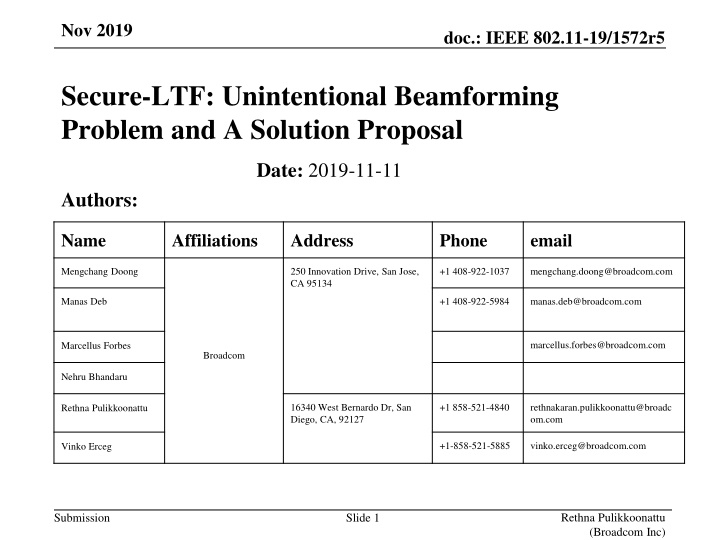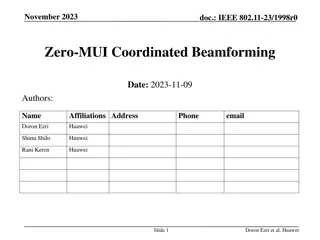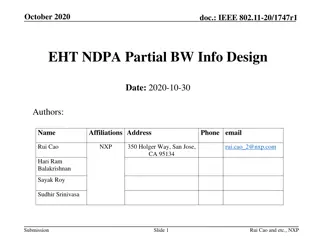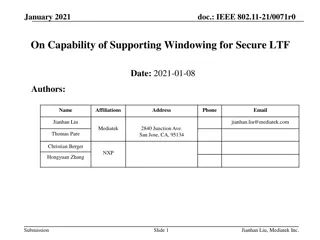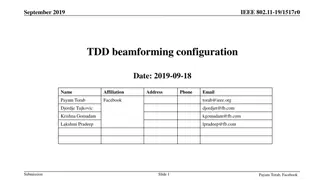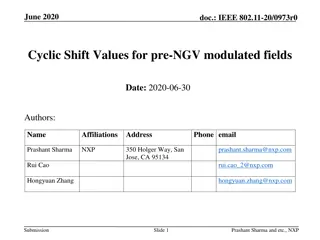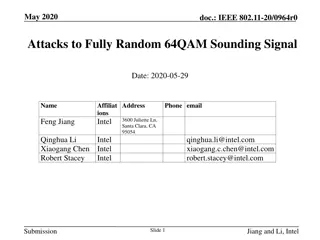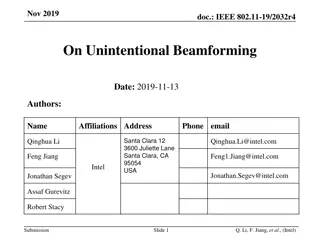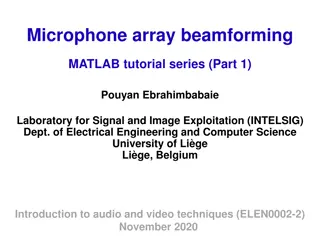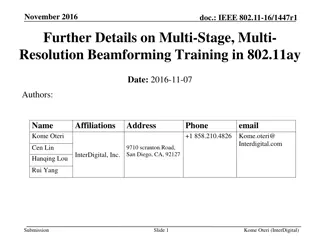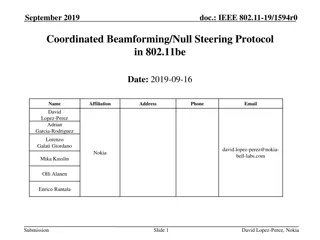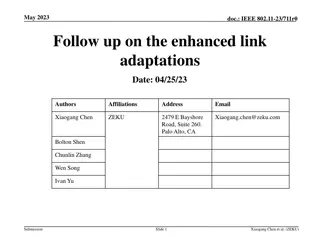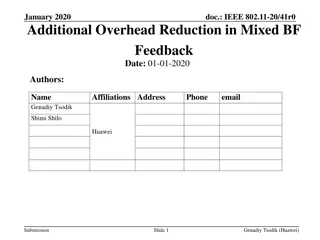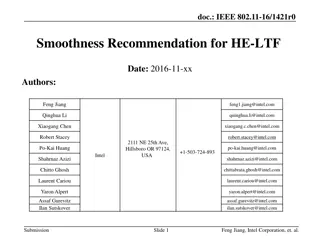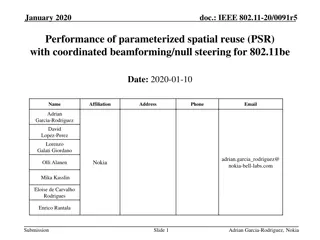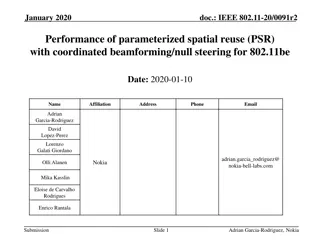Unintentional Beamforming Issue in IEEE 802.11-19/1572r5 Secure-LTF Design
This document addresses a potential problem in the secure LTF sequence design of IEEE 802.11-19/1572r5, focusing on unintentional beamforming during multi-stream scenarios which can lead to dynamic range complications at the receiver. The proposal offers a solution to mitigate this issue by revising the existing design. The presentation by Broadcom Inc. delves into the details of the problem and the suggested resolution.
Uploaded on Sep 20, 2024 | 1 Views
Download Presentation

Please find below an Image/Link to download the presentation.
The content on the website is provided AS IS for your information and personal use only. It may not be sold, licensed, or shared on other websites without obtaining consent from the author.If you encounter any issues during the download, it is possible that the publisher has removed the file from their server.
You are allowed to download the files provided on this website for personal or commercial use, subject to the condition that they are used lawfully. All files are the property of their respective owners.
The content on the website is provided AS IS for your information and personal use only. It may not be sold, licensed, or shared on other websites without obtaining consent from the author.
E N D
Presentation Transcript
Nov 2019 doc.: IEEE 802.11-19/1572r5 Secure-LTF: Unintentional Beamforming Problem and A Solution Proposal Date: 2019-11-1117-12-14 Authors: Name Affiliations Address Phone email Mengchang Doong 250 Innovation Drive, San Jose, CA 95134 +1 408-922-1037 mengchang.doong@broadcom.com Manas Deb +1 408-922-5984 manas.deb@broadcom.com marcellus.forbes@broadcom.com Marcellus Forbes Broadcom Nehru Bhandaru 16340 West Bernardo Dr, San Diego, CA, 92127 +1 858-521-4840 rethnakaran.pulikkoonattu@broadc om.com Rethna Pulikkoonattu +1-858-521-5885 vinko.erceg@broadcom.com Vinko Erceg Rethna Pulikkoonattu (Broadcom Inc) Submission Slide 1
Nov 2019 doc.: IEEE 802.11-19/1572r5 Abstract This document highlights a potential problem with the existing design of secure LTF sequence. In its present form, while in multi stream scenario, unintentional Beamforming (constructive and destructive addition of signals) could take place during the secure LTF transmission portion, which leads to dynamic range complications at the receiver. We propose a possible solution to mitigate the problem. Rethna Pulikkoonattu (Broadcom Inc) Submission Slide 2
Nov 2019 doc.: IEEE 802.11-19/1572r5 Secure-LTF Generation (from .11az/D1.0) P bits CS CSD Value Generator Zero-GI and Windowing IDFT Zero-GI and Windowing 3P+3 bits IDFT PHE_LTF Matrix Mapping 8PSK Sequence Generator Subcarrier Mapper Frame Format Construction CSD Randomized LTF Sequence 2P8PSK symbols Zero-GI and Windowing IDFT Additional notes from .11az/D1.0 No single stream pilot subcarriers in the secure HE-LTFs, all subcarriers are mapped using the full P-HE-LTF matrix. No CSD is applied to the space-time streams. No spatial mapping, the Q matrix is a block identity matrix. P ={7, 8, 9, 10} for {20, 40, 80,160/80+80} MHz PHY BW. Rethna Pulikkoonattu (Broadcom Inc) Submission Slide 3
Nov 2019 doc.: IEEE 802.11-19/1572r5 Secure-LTF (Present Design): N_STS=2 and LTF_REP = 2 HE- STF TX Stream 1 Seq1 - Seq2 Seq3 - Seq4 HE- STF TX Stream 2 Seq1 Seq2 Seq3 Seq4 The waveforms on TX stream 1 and stream 2 are perfectly aligned (in time domain, either in-phase or 180 degrees out of phase), causing unintentional beamforming, by way of constructive/destructive addition of signal. Seq1, Seq2, Seq3 and Seq4 are generated from 4 different sets of 4P+3 bits. Rethna Pulikkoonattu (Broadcom Inc) Submission Slide 4
Nov 2019 doc.: IEEE 802.11-19/1572r5 Secure-LTF (Existing Design): N_STS=2 and LTF_REP = 2 HE- STF Seq1 - Seq2 Seq3 - Seq4 TX Stream 1 HE- STF TX Stream 2 Seq1 Seq2 Seq3 Seq4 3dB average power increase. 9.6us RX RSSI 3dB Destructive interference RX signal energy stays low for 9.6us, which may cause RX packet abortion. Constructive interference Zero GI In case of in-phase LOS or some flat-fading cases (small indoor environment) Rethna Pulikkoonattu (Broadcom Inc) Submission Slide 5
Nov 2019 doc.: IEEE 802.11-19/1572r5 Existing LTF: RX Waveform (Simulation) chan_indx = 2 Simulation with TGnB Channel model If no per-STS CSD is applied, unintentional beamforming can take place, resulting in a higher signal amplitude fluctuation in the time domain. This behavior will eat up the dynamic range of receiver circuitry PE HE-LTF1 HE-LTF2 HE-STF L-STF L-LTF L-SIG RL-SIG HE-SIG AGC in work Larger-than-usual signal amplitude caused by un-intentional beamforming (constructive interference). Smaller-than-usual signal amplitude caused by un-intentional beamforming (destructive interference). Rethna Pulikkoonattu (Broadcom Inc) Submission Slide 6
Nov 2019 doc.: IEEE 802.11-19/1572r5 Potential Problems Circuit dynamic range The secure-LTF signal power at the receiver may end up boosted by up to 10*log10(N_STS) dB. Similarly, part of the LTF signal could be completely nulled out due to the destructive addition. N_STS=2, can result in 3dB boost or a nulling. Can happen ~10% of time. RX power can increase by up to 9 dB (for 8 TX stream case) when coherent interference happens. Extra circuit dynamic range will be required to accommodate such excessive power swing. Regulatory concerns Abrupt increase in power is a concern in some regulator domain SNR loss due to Channel Estimation Up to 1.2494 dB (=3-1.761 dB) (Theoretical max loss) Rethna Pulikkoonattu (Broadcom Inc) Submission Slide 7
Nov 2019 doc.: IEEE 802.11-19/1572r5 Secure LTF design Proposal: Illustration for N_STS=2 and LTF_REP = 2 A1 - A2 B1 - B2 TX Stream 1 A3 A4 B3 B4 TX Stream 2 A1, A2, A3 and A4 are different secure-LTF sequences, which can be generated by the procedure described in .11az. With the following rule, the complexity increment for channel estimation is kept minimum compared to existing design in .11az. Matrix inversion is not necessary!! Only need extra phase rotations on H12 and H22 after the typical channel estimation procedure. The (time-domain) waveforms on TX stream 1 and TX stream 2, will look totally different. Improve randomness and thus the overall security The unintentional beamforming gets resolved Rule: Sequence A1, A2 are generated from 2 different (and independent) sets of 4P+3 bits. They are polyphase Golay codes. The 8PSK sequence of A3 are generated from another independent set of 3P+3 bits. The az_csd of A3 is the same as A1. The 8PSK sequence of A4 is generated from 3P+3 bits which are a simple function of the previous 3 sets of 3P+3 bits. The az_csd of A4 is the same as A2. The function to generate 3P+3 bits for A4 is described in the subsequent pages. Rethna Pulikkoonattu (Broadcom Inc) Submission Slide 8
Nov 2019 doc.: IEEE 802.11-19/1572r5 Proposed Design: RX Waveform (Simulation) With this proposal, the unintentional beamforming behavior is minimized. RX signal power stays even. PE HE-LTF1 HE-LTF2 HE-STF L-STF L-LTF L-SIG RL-SIG HE-SIG AGC in work Rethna Pulikkoonattu (Broadcom Inc) Submission Slide 9
Nov 2019 doc.: IEEE 802.11-19/1572r5 LTF generation : Recap of the 4P+3 bits and the iterative process The 4P+3 bits can be divided into groups as shown below: These P bits are used to generate the az_csd. These 3P+3 = 3(P+1) bits are used to generate the 8PSK secured sequence. bP+3, bP+4, bP+5, b0, b1, bP-1, bP, bP+1, bP+2, bP+6, bP+7, bP+8, bP+9, bP+10, bP+11, b4P, b4P+1, b4P+2 s1(0)= exp(j 1) s2(0)= exp(j 2) P-1= exp(j P-1) 1= exp(j 1) 2= exp(j 2) secure az_csd Initial values The iterative process A sequence of 2P8PSK symbols are generated by P-1 iterations. Rethna Pulikkoonattu (Broadcom Inc) Submission Slide 10
Nov 2019 doc.: IEEE 802.11-19/1572r5 The Rule and notations b0, b1, bP-1, bP, bP+1, bP+2, b4P, b4P+1, b4P+2 bP+3, bP+4, bP+5, bP+6, bP+7, bP+8, bP+9, bP+10, bP+11, P-1= exp(j P-1) 1= exp(j 1) 2= exp(j 2) s1(0)= exp(j 1) s2(0)= exp(j 2) secured az_csd CS 2_A1 1_A1 2_A1 P-1_A1 1_A1 For A1 CS_A1 For A2 2_A2 1_A2 2_A2 P-1_A2 1_A2 CS_A2 2_A3 1_A3 2_A3 P-1_A3 For A3 1_A3 CS_A3= CS_A1 1_A4 2_A4 1_A4 = 1_A1 + 1_A2 + 1_A3 2_A4 = 2_A1 + 2_A2 + 2_A3 For A4 CS_A4= CS_A2 = 1_A1 + 1_A2 + 1_A3 = 2_A1 + 2_A2 + 2_A3 P-1_A4 = P-1_A1 + P-1_A2 + P-1_A3 We will explain why we choose this -++ rule in the following pages. Rethna Pulikkoonattu (Broadcom Inc) Submission Slide 11
Nov 2019 doc.: IEEE 802.11-19/1572r5 Notations and Equations to represent the function The 4P+3 bits for A1,A2, A3 and A4 are denoted by For A1: b1ifor i=0, 4P+2. Secure bits required: 4P+3 For A2: b2ifor i=0, 4P+2. Secure bits required: 4P+3. For A3: b3ifor i=0, 4P+2. Secure bits required: 3P+3. For A4: b4ifor i=0, 4P+2. Secure bits required: 0. b3i= b1ifor i=0, P-1 same az_csd for A1 and A3 b4i= b2ifor i=0, P-1 same az_csd for A2 and A4 For A4 s1(0) ?=? For A4 s2(0) ?=?+3 b4i 2? ? 3= ??? ?=?+3 For A4 p ?=?+3?+3 b4i 2? ? 3? 3= ???( ?=?+3?+3 for p=1, ,P-1 ?+2b4i 2? ?= ???( ?=? ?+2b1i 2? ?+ ?=? ?+2b2i 2? ?+ ?=? ?+2b3i 2? ?,8) ?+5 ?+5 ?+5 ?+5 b1i 2? ? 3+ ?=?+3 b2i 2? ? 3+ ?=?+3 b3i 2? ? 3,8 ?+3?+5 ?+3?+5 ?+3?+5 ?+3?+5 b1i 2? ? 3? 3+ ?=?+3?+3 b2i 2? ? 3? 3+ ?=?+3?+3 b3i 2? ? 3? 3,8) Rethna Pulikkoonattu (Broadcom Inc) Submission Slide 12
Nov 2019 doc.: IEEE 802.11-19/1572r5 The iterative process Note: p= - exp(j p) = exp( j( p+ ) ) s1(0)= exp(j 1) s2(0)= exp(j 2) s1(1)= [ exp( j 1 ) , exp( j 2 ) ] s2(1)= [ exp( j( 1+ 1) ) , exp( j( 2+ 1+ ) ) ] 1 Phase of s1(0) initialization 2 Phase of s2(0) 1 2 Phase of s1(1) Iteration 1 1+ 1 2+ 1+ Phase of s2(1) 1 2 1+ 1 2+ 1+ Phase of s1(2) Iteration 2 1+ 2 2+ 2 1+ 1+ 2+ 2+ 1+ 2 Phase of s2(2) 1 2 1+ 1 2+ 1+ 1+ 2 2+ 2 1+ 1+ 2+ 2+ 1+ 2 Phase of s1(3) Iteration 3 1+ 3 2+ 3 1+ 1+ 3 2+ 1+ 3+ 1+ 2+ 3+ 2+ 2+ 3+ 1+ 1+ 2+ 3 2+ 1+ 2+ 3+ Phase of s2(3) Rethna Pulikkoonattu (Broadcom Inc) Submission Slide 13
Nov 2019 doc.: IEEE 802.11-19/1572r5 For A4 (using iteration 2 as an illustration) 1_A4 Phase of s1(0) initialization 2_A4 Phase of s2(0) 1_A4 2_A4 Phase of s1(1) Iteration 1 1_A4+ 1_A4 2_A4+ 1_A4+ Phase of s2(1) 1_A4 2_A4 1_A4+ 1_A4 2_A4+ 1_A4+ Phase of s1(2) Iteration 2 1_A4+ 2_A4 2_A4+ 2_A4 1_A4+ 1_A4+ 2_A4+ 2_A4+ 1_A4+ 2_A4 Phase of s2(2) Re-notation 11_A4 12_A4 13_A4 14_A4 Phase of s1(2) Apply similar notation for A1, A2 and A3 21_A4 22_A4 23_A4 24_A4 Phase of s2(2) Using the rule mentioned earlier, it can be rewritten as 11_A1 + 11_A2 + 11_A3 12_A1 + 12_A2 + 12_A3 13_A1 + 13_A2 + 13_A3 14_A1 + 14_A2 + 14_A3 Phase of s1(2) Phase addition is equivalent to value multiplication. Phase subtraction is equivalent to value division. 21_A1 + 21_A2 + 21_A3 22_A1 + 22_A2 + 22_A3 23_A1 + 23_A2 + 23_A3 24_A1 + 24_A2 + 24_A3 Phase of s2(2) .* and ./ denote point-wise multiplication and division for each element in the array. In our case, it means frequency domain point-wise operation. This relationship holds for all iterations. The final sequence A4 = A2 .* A3 ./ A1 We have just proven that the A4=A2.*A3./A1 is constructed with the same structure as A1, A2 and A3, and is therefore a Polyphase Golay sequence with the same PAPR as others. Rethna Pulikkoonattu (Broadcom Inc) Submission Slide 14
Nov 2019 doc.: IEEE 802.11-19/1572r5 Illustration for Channel Estimation TX Stream 1 A1 - A2 B1 - B2 A3= A4= B3= B4= TX Stream 2 A1.*(A3./A1) A2.*(A3./A1) B1.*(B3./B1) B2.*(B3./B1) Since this term is a fixed value within one repetition period, it can be viewed as part of the channel response. Since (A3./A1) is known, we can compensate for it after typical channel estimation block. [A1, A2 ] RX TX [A1, -A2 ] h11 TX stream 1 Est{ h11 } h12 Typical Channel Estimation Est{ h12 } .*(A1./A3) Est{ h21 } h21 [A1, A2 ] [A3, A4 ] Est{ h22 } .*(A1./A3) TX stream 2 .*(A3./A1) h22 Since A1 and A3 are 8PSK sequences, .*(A3./A1) and .*(A1./A3) are just phase rotations. Rethna Pulikkoonattu (Broadcom Inc) Submission Slide 15
Nov 2019 doc.: IEEE 802.11-19/1572r5 Extension to larger spatial streams (e.g., N_STS=4 ) Easily scalable to arbitrary number of spatial streams Needs ( 2 * NHE_LTF- 1 ) additional secured sequences required TX Stream 1 A1 - A2 A3 A4 TX Stream 2 A5 A2.*A5./A1 -A3.*A5./A1 A4.*A5./A1 TX Stream 3 A6 A2.*A6./A1 A3.*A6./A1 -A4.*A6./A1 TX Stream 4 -A7 A2.*A7./A1 A3.*A7./A1 A4.*A7./A1 Rethna Pulikkoonattu (Broadcom Inc) Submission Slide 16
Nov 2019 doc.: IEEE 802.11-19/1572r5 Matrix constructed in this manner is always invertible It is a Hadamard matrix scaled by diagonal matrices. Sequence properties (e.g., orthogonality, PAPR etc., ) are retained NHE_LTF= 2 ? ? ?? ? 0 ? 1 1 0 ? ? 0 0 ? 1 1 1 = ? NHE_LTF= 4 ? ? ? ? ?? ? ?? 1 0 0 ? ? 0 0 0 0 0 0 1 1 1 1 1 1 1 1 1 1 ? 0 0 0 0 ? 0 0 0 0 ? 0 0 0 0 ? ?? ? ?? ? ?? ? ?? ? 1 1 1 = ?? ? ?? ? ? ? 0 ? 0 0 0 ? ? 1 1 ? 1 ?? ? ? Rethna Pulikkoonattu (Broadcom Inc) Submission Slide 17
Nov 2019 doc.: IEEE 802.11-19/1572r5 Matrix constructed in this manner is always invertible N NHE_LTF HE_LTF= 6 ( = 6 (Orthogonal:Vandemonde Orthogonal:Vandemonde, Signature, diagonal matrices) , Signature, diagonal matrices) ? ? ? ? ? ? ? ?5?? ?1?? ?2?? ?3?? ?4?? ? ? ? ? ? ?2? ?4? ?6? ?8? ?10? ? ? ? ? ? ?3?? ?6?? ?9?? ?12?? ?15?? i ? ? ? ? ? ?4?? ?8?? ?12?? ?16?? ?20?? ? ? ? ? ? ? ?5?? ?10?? ?15?? ?20?? ?25?? ? ? ? ? ? ? 1 0 0 ? ? 0 0 0 0 0 0 0 0 0 ? 0 0 0 0 0 0 ? 0 0 0 0 0 0 ? 0 0 0 0 0 0 ? 0 0 0 0 0 0 ? 0 0 0 0 0 0 ? 1 1 1 1 1 1 1 ?1 ?2 ?3 ?4 ?5 1 ?2 ?4 ?6 ?8 ?10 1 ?3 ?6 ?9 ?12 ?15 1 ?4 ?8 ?12 ?16 ?20 1 ?5 ?10 ?15 ?20 ?25 ? 0 0 0 0 0 = ? ? 0 0 0 0 0 ? ? 0 0 0 0 0 ? ? 0 0 0 0 where ? = ? ?2 ? 6 Rethna Pulikkoonattu (Broadcom Inc) Submission Slide 18
Nov 2019 doc.: IEEE 802.11-19/1572r5 Matrix constructed in this manner is always invertible N NHE_LTF HE_LTF= 8 = 8 ? ? ? ? ??/? ??/? ??/? ??/? bn/a ??/? ??/? 0 0 0 0 ? ? ? ? ??/? ??/? ??/? ??/? ??/? ??/? ??/? ? ??/? ??/? ??/? ??/? ??/? ??/? ??/? ??/? ??/? ??/? ??/? ??/? ??/? ??/? ??/? ??/? ??/? ??/? ??/? ??/? ??/? ??/? ??/? ??/? ??/? ??/? ??/? ??/? ?/? ?/? ?/? ?/? ?/? ?/? ?/? ? ? ? ? ? 0 0 1 0 0 ? ? 0 0 0 0 0 0 0 ? 0 0 0 0 0 0 0 0 ? 0 0 0 0 0 0 0 0 ? 0 0 0 0 0 0 0 0 ? 0 0 0 0 0 0 0 0 ? 0 0 0 0 0 0 0 0 ? 0 0 0 0 0 0 0 0 ? 0 0 0 0 0 0 0 0 1 1 1 1 1 1 1 1 1 1 1 1 1 1 1 1 1 1 1 1 1 1 1 1 1 1 1 1 1 1 1 1 1 1 1 1 1 1 1 1 1 1 ? ? 0 0 0 0 0 0 0 0 0 0 0 1 1 1 1 1 1 1 1 1 1 1 1 ? ? 0 0 0 0 0 0 0 0 0 0 0 0 0 0 0 ? ? 0 0 0 0 0 ? ? 0 0 0 0 0 ? ? 0 0 0 0 0 ? ? 1 1 1 1 1 1 1 1 1 1 = Rethna Pulikkoonattu (Broadcom Inc) Submission Slide 19
Nov 2019 doc.: IEEE 802.11-19/1572r5 Conclusion MIMO mode needs modification in Secure LTF design Simple, scalable scheme exist to address the problem. One scheme is presented here. Very minimal change in the receiver (channel estimation) A byproduct of this design is that, it also helps to make the system more secure. Rethna Pulikkoonattu (Broadcom Inc) Submission Slide 20
Nov 2019 doc.: IEEE 802.11-19/1572r5 Straw Poll 1 Do you agree that the present 802.11az secure ranging LTF design, leads to unintended beamforming problem, which needs to be addressed? Yes No Abstain Rethna Pulikkoonattu (Broadcom Inc) Submission Slide 21
Nov 2019 doc.: IEEE 802.11-19/1572r5 Appendix Rethna Pulikkoonattu (Broadcom Inc) Submission Slide 22
Nov 2019 doc.: IEEE 802.11-19/1572r5 Matrix constructed in this manner is always invertible NHE_LTF= 2 ? 1 1 ? 1 ? ? ?? ? ?? ? =1 1 2 ? ? NHE_LTF= 4 1 ? 1 ? ? ?? ? ?? ? ?? 1 ? ? ?? ? ?? ? ?? 1 1 ? ? ?? ? ?? ? ?? ? ? ? ?? ? ?? ? ?? 1 ? =1 ? ? ?? ? ?? ? ?? ?? ? ?? ? ? 1 ? 1 ? 4 ? ?? ? ? Rethna Pulikkoonattu (Broadcom Inc) Submission Slide 23
Nov 2019 doc.: IEEE 802.11-19/1572r5 Matrix constructed in this manner is always invertible N NHE_LTF HE_LTF= 6 = 6 1 ? 1 ? 1 1 ? 1 ? 1 ? 1 ? ? ? ?1?? ? ? ? ? ?5?? 1 ? 1? ? 2? ? 3? ? 4? ? 5? ?2?? ?3?? ?4?? ? ?? ? ?? ?? ?? ? ? ? ? ? ?10? ?2? ?4? ?6? ?8? 1 ? 1 ? 1 ? ? 2? ? 4? ? 6? ? 8? ? 10? =1 ? ? ? ? ? ?? ? ?? ?? ?? ?15?? ?3?? ?6?? ?9?? ?12?? ? 3? ? 6? ? 9? ? 12? ? 15? i 6 ? ? ? ? ? ?? ? ?? ?? ?? ?4?? ?8?? ?12?? ?16?? ?20?? ? ? 4? ? 8? ? 12? ? 16? ? 20? ? ? ? ? ? ?? ? ?? ?? ?? ?25?? ?5?? ?10?? ?15?? ?20?? ? 1 ? 5? ? 10? ? 15? ?20? ? 25? ? ? ? ? ? ? ?? ? ?? ?? ?? where ? = ? ?2 ? 6 Rethna Pulikkoonattu (Broadcom Inc) Submission Slide 24
Nov 2019 doc.: IEEE 802.11-19/1572r5 Matrix constructed in this manner is always invertible NHE_LTF= 8 1 ? ? ? ? ??/? ??/? ??/? ??/? ??/? ??/? ??/? ? ? ? ? ??/? ??/? ??/? ??/? ??/? ??/? ??/? 1/? ? ?? ? ?? ? ?? ? ?? ? ?? ? ?? ? ? ? ??/? ??/? ??/? ??/? ??/? ??/? ??/? 1/? 1/? ??/? ??/? ??/? ??/? ??/? ??/? ??/? 1/? ? ?? ? ?? ? ?? ? ?? ? ?? ? ?? ? ? ??/? ??/? ??/? ??/? ??/? ??/? ??/? 1/? ? ?? ? ?? ? ?? ? ?? ? ?? ? ?? ? ? ??/? ??/? ??/? ??/? ??/? ??/? ??/? 1/? ? ?? ? ?? ? ?? ? ?? ? ?? ? ?? ? ? ?/? ?/? ?/? ?/? ?/? ?/? ?/? 1/? ? ?? ? ?? ? ?? ? ?? ? ?? ? ?? ? ? ? ? ? ? ? 1/? ? ?? ? 1/? ? ?? ? 1/? ?? ? ?? ? ?? ? ?? ? ?? ? ?? ? ?? ? ?? ? ?? ? ? 1/? =1 1/? 8 1/? 1/? ?? ? ? 1/ Rethna Pulikkoonattu (Broadcom Inc) Submission Slide 25
Nov 2019 doc.: IEEE 802.11-19/1572r5 Math for Channel Estimation (using 2x2 as an example) Assume the frequency domain value of the kthtone for sequence A1, A2 and A3 are A1k, A2kand A3krespectively. Since A1kand A3kare 8PSK symbols, A1k and A3kcan be written as exp( j * A1k) and exp( j * A3k) respectively. The k_th tone being send out through the two antennas: Symbol: n n+1 n+2 n+3 TX Ant 0: A1k -A2k TX Ant 1: A3k A2k*exp( j* A3k)*exp( -j* A1k) B3k We can rewrite them as (only show symbol n and n+1) Symbol: n TX Ant 0: A1k -A2k TX Ant 1: A1k*exp( j* A3k)*exp( -j* A1k) A2k*exp( j* A3k)*exp( -j* A1k) B1k -B2k B2k*exp( j* B3k)*exp( -j* B1k) n+1 Rethna Pulikkoonattu (Broadcom Inc) Submission Slide 26
Nov 2019 doc.: IEEE 802.11-19/1572r5 Math for Channel Estimation (using 2x2 as an example) If the channel matrix for kthtone is Hk=[ h11_kh12_k; h21_kh22_k], then at the receiver for symbol n and n+1, we get (ignoring noise): RX Ant 0: y1[n] = h11_k* A1k + h12_k* A1k*exp( j* A3k)*exp( -j* A1k) y1[n+1] = h11_k* (-A2k)+ h12_k* A2k*exp( j* A3k)*exp( -j* A1k) RX Ant 1: y2[n] = h21_k* A1k + h22_k* A1k*exp( j* A3k)*exp( -j* A1k) y2[n+1] = h21_k* (-A2k)+ h22_k* A2k*exp( j* A3k)*exp( -j* A1k) We can write H12_k = h12_k*exp( j* A3k)*exp( -j* A1k) H22_k = h22_k*exp( j* A3k)*exp( -j* A1k) Substituting these into the equations, we get RX Ant 0: y1[n] = h11_k* A1k+ h12_k * A1k y1[n+1] = h11_k* (-A2k)+ h12_k * A2k RX Ant 1: y2[n] = h21_k* A1k+ h22_k * A1k y2[n+1] = h21_k* (-A2k)+ h22_k * A2k Rethna Pulikkoonattu (Broadcom Inc) Submission Slide 27
Nov 2019 doc.: IEEE 802.11-19/1572r5 Math for Channel Estimation (using 2x2 as an example) Now we can solve h11, h12 , h21and h22 from previous equations RX Ant 0: y1[n] / A1k = h11_k+ h12_k y1[n+1] / A2k= h11_k+ h12_k RX Ant 1: y2[n] / A1k = h21_k+ h22_k y2[n+1] / A2k= h21_k+ h22_k By adding and subtracting the equations RX Ant 0 h11_k= ( y1[n] / A1k- y1[n+1] / A2k) /2 h12_k = ( y1[n] / A1k+ y1[n+1] / A2k) /2 RX Ant 1 h21_k= ( y2[n] / A2k- y2[n+1] / A2k) /2 h22_k = ( y2[n] / A2k+ y2[n+1] / A2k) /2 After we solve h12_k and h22_k , we can then compensate for the phase shift and get h12_k and h22_k h12_k= h12_k * exp( -j * A3k) * exp( j * A1k) h22_k= h22_k * exp( -j * A3k) * exp( j * A1k) Rethna Pulikkoonattu (Broadcom Inc) Submission Slide 28
